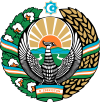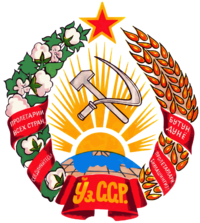
Coat of arms of Uzbekistan
Encyclopedia


Uzbekistan
Uzbekistan , officially the Republic of Uzbekistan is a doubly landlocked country in Central Asia and one of the six independent Turkic states. It shares borders with Kazakhstan to the west and to the north, Kyrgyzstan and Tajikistan to the east, and Afghanistan and Turkmenistan to the south....
was adopted on July 2, 1992. It is similar to the emblem of the previous Uzbek SSR
Uzbek SSR
The Uzbek Soviet Socialist Republic , also known as the Uzbek SSR for short, was one of the republics of the Soviet Union since its creation in 1924...
. Like other post-Soviet republics whose symbols do not predate the October Revolution
October Revolution
The October Revolution , also known as the Great October Socialist Revolution , Red October, the October Uprising or the Bolshevik Revolution, was a political revolution and a part of the Russian Revolution of 1917...
, the current emblem retains some components of the Soviet one.
The emblem is in the form of a circle and mainly bears the national colors blue, white, and green. On the left there is a cotton
Cotton
Cotton is a soft, fluffy staple fiber that grows in a boll, or protective capsule, around the seeds of cotton plants of the genus Gossypium. The fiber is almost pure cellulose. The botanical purpose of cotton fiber is to aid in seed dispersal....
plant and to the right wheat
Wheat
Wheat is a cereal grain, originally from the Levant region of the Near East, but now cultivated worldwide. In 2007 world production of wheat was 607 million tons, making it the third most-produced cereal after maize and rice...
borders the coat of arms, cotton and wheat are the two major agricultural products of the country.
It is surmounted by the star of Rub El Hizb
Rub El Hizb
The Rub el Hizb is a Muslim symbol, represented as two overlapping squares, which is found on a number of emblems and flags. In Arabic, Rubʻ means "one fourth, quarter", while Hizb means a group or party...
(۞), a symbol of Islam
Islam
Islam . The most common are and . : Arabic pronunciation varies regionally. The first vowel ranges from ~~. The second vowel ranges from ~~~...
, which a majority of Uzbeks profess.
In the middle, a khumo
Huma (mythology)
The Huma , also Homa, is a legendary bird especially of the Persian branch of Iranian mythology and Sufi fable. It is said to never come to rest, living its entire life flying invisibly high above the earth, and never alighting on the ground .-Etymology:The word Huma which has a Persian origin is...
, symbol of happiness and love of freedom, beats its wings. In the background a birdseye view of Uzbekistan is painted. The rising sun
Sun
The Sun is the star at the center of the Solar System. It is almost perfectly spherical and consists of hot plasma interwoven with magnetic fields...
over the mountains with its sun rays rounds off the image.
The two rivers behind the bird, leading to the mountains, symbolize the Amu Darya
Amu Darya
The Amu Darya , also called Oxus and Amu River, is a major river in Central Asia. It is formed by the junction of the Vakhsh and Panj rivers...
and Syr Darya
Syr Darya
The Syr Darya , also transliterated Syrdarya or Sirdaryo, is a river in Central Asia, sometimes known as the Jaxartes or Yaxartes from its Ancient Greek name . The Greek name is derived from Old Persian, Yakhsha Arta , a reference to the color of the river's water...
.

